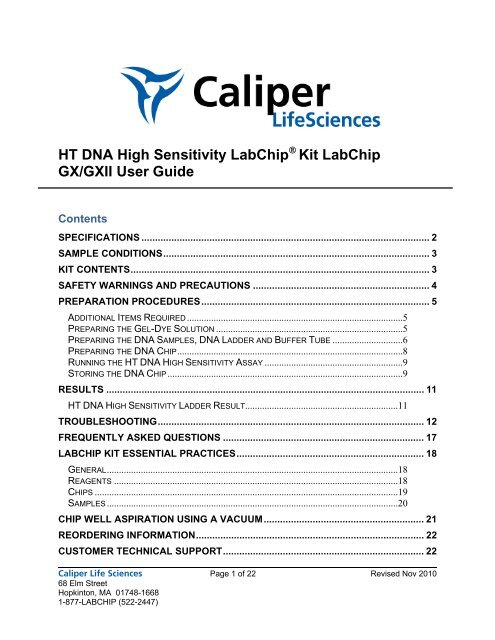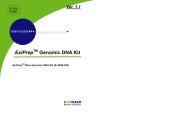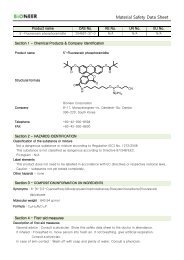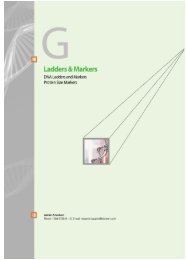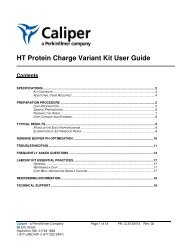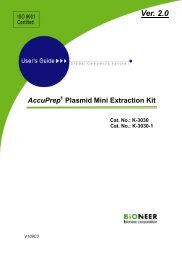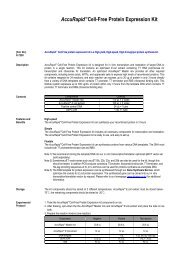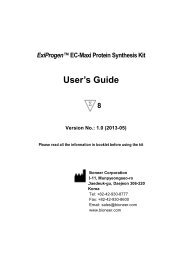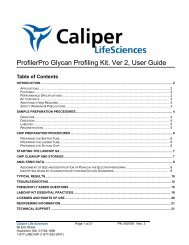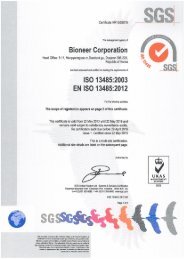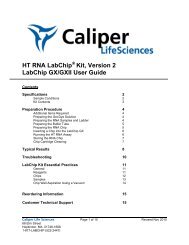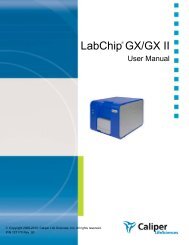HT DNA High Sensitivity LabChip Kit LabChip GX/GXII User Guide
HT DNA High Sensitivity LabChip Kit LabChip GX/GXII User Guide
HT DNA High Sensitivity LabChip Kit LabChip GX/GXII User Guide
- No tags were found...
Create successful ePaper yourself
Turn your PDF publications into a flip-book with our unique Google optimized e-Paper software.
<strong>HT</strong> <strong>DNA</strong> <strong>High</strong> <strong>Sensitivity</strong> <strong>LabChip</strong> ® <strong>Kit</strong> <strong>LabChip</strong><strong>GX</strong>/<strong>GX</strong>II <strong>User</strong> <strong>Guide</strong>ContentsSPECIFICATIONS .......................................................................................................... 2SAMPLE CONDITIONS .................................................................................................. 3KIT CONTENTS .............................................................................................................. 3SAFETY WARNINGS AND PRECAUTIONS ................................................................. 4PREPARATION PROCEDURES .................................................................................... 5ADDITIONAL ITEMS REQUIRED .........................................................................................5PREPARING THE GEL-DYE SOLUTION .............................................................................5PREPARING THE <strong>DNA</strong> SAMPLES, <strong>DNA</strong> LADDER AND BUFFER TUBE .............................6PREPARING THE <strong>DNA</strong> CHIP .............................................................................................8RUNNING THE <strong>HT</strong> <strong>DNA</strong> HIGH SENSITIVITY ASSAY .........................................................9STORING THE <strong>DNA</strong> CHIP .................................................................................................9RESULTS ..................................................................................................................... 11<strong>HT</strong> <strong>DNA</strong> HIGH SENSITIVITY LADDER RESULT...............................................................11TROUBLESHOOTING .................................................................................................. 12FREQUENTLY ASKED QUESTIONS .......................................................................... 17LABCHIP KIT ESSENTIAL PRACTICES ..................................................................... 18GENERAL ........................................................................................................................18REAGENTS .....................................................................................................................18CHIPS .............................................................................................................................19SAMPLES ........................................................................................................................20CHIP WELL ASPIRATION USING A VACUUM ........................................................... 21REORDERING INFORMATION .................................................................................... 22CUSTOMER TECHNICAL SUPPORT .......................................................................... 22Caliper Life Sciences Page 1 of 22 Revised Nov 201068 Elm StreetHopkinton, MA 01748-16681-877-LABCHIP (522-2447)
<strong>HT</strong> <strong>DNA</strong> <strong>High</strong> <strong>Sensitivity</strong> <strong>LabChip</strong> ® <strong>Kit</strong><strong>LabChip</strong> <strong>GX</strong>/<strong>GX</strong>II <strong>User</strong> <strong>Guide</strong>Specifications 1Sizing Range50 – 5000 bpSizing Resolution 2Sizing Accuracy ± 10%Sizing PrecisionLinear Concentration Range<strong>Sensitivity</strong>Maximum Total <strong>DNA</strong> Concentration± 5% from 100 – 500 bp± 10% from 50 – 100 bp, 500 – 1000 bp± 15% from 1000 – 3000 bp± 22% from 3000 - 5000 bp5% CVCarry-Over < 0.25%Quantitation Accuracy ± 30%Quantitation PrecisionChip Lifetime 3Number of Samples per Chip PrepStandard Sample Workflow10 pg/μL – 500 pg/μL per fragment from 50 bp to 2000 bp50 pg/μL – 500 pg/μL per fragment from 2000 bp to 5000 bp100 pg/μL – 5 ng/μL for smearsLimited Sample Workflow (initial concentration)20 pg/μL – 500 pg/μL per fragment from 50 bp to 2000 bp100 pg/μL – 500 pg/μL per fragment from 2000 bp to 5000 bp200 pg/μL – 5 ng/μL for smearsStandard Workflow5 pg/μL per fragment100 pg/μL for smearsLimited Sample Workflow (initial concentration)10 pg/μL per fragment200 pg/μL for smears5 ng/μL total, 500 pg/μL per fragment20% CV2000 samples per chip96 samples1 All specifications pertaining to <strong>DNA</strong> fragments were determined using ladder as sample in TE buffer. All specifications pertaining to <strong>DNA</strong> smearswere determined using Covaris sheared control genomic <strong>DNA</strong> (human male) in TE buffer. Shearing time was 30s or 240s.2 Resolution is defined as half height or better separation of two peaks. Actual separation performance can depend on the sample and application.Peaks that are resolved less than half height can still be accurately identified by the system software.3 Expected chip lifetime is based on use under normal laboratory conditions and adherence to Caliper preparation protocols, sample guidelines andstorage conditions. Individual results may vary.Caliper Life Sciences Page 2 of 22 Revised Nov 201068 Elm StreetHopkinton, MA 01748-16681-877-LABCHIP (522-2447)
<strong>HT</strong> <strong>DNA</strong> <strong>High</strong> <strong>Sensitivity</strong> <strong>LabChip</strong> ® <strong>Kit</strong><strong>LabChip</strong> <strong>GX</strong>/<strong>GX</strong>II <strong>User</strong> <strong>Guide</strong>Sample ConditionsAdditivesCaliper recommends that BSA and detergents exceeding 0.05 mg/mL and 0.01%(v/v) respectively in concentration not be used. <strong>High</strong>er concentrations can result inchip failure. In addition, non-aqueous solvents are not compatible with <strong>DNA</strong><strong>LabChip</strong> protocols.ParticulatesAll sample plates should be spun down prior to analysis. All buffers should befiltered with a 0.22 μm cellulose acetate filter.Salt ConcentrationTotal salt concentration must not exceed 10 mM Tris and 1 mM EDTA for the <strong>HT</strong><strong>DNA</strong> <strong>High</strong> <strong>Sensitivity</strong> assay. <strong>High</strong>er salt concentrations and different ions mayalter performance and reduce assay sensitivity.<strong>Kit</strong> Contents<strong>HT</strong> <strong>DNA</strong> <strong>High</strong> <strong>Sensitivity</strong> Reagent <strong>Kit</strong>Part Number 760568<strong>Kit</strong> contains enough reagents for 5 chip preparations.Item Vial Quantity<strong>DNA</strong> Dye Concentrate Blue 1 vial of 0.04 mLChip Storage Buffer White 3 vials, 1.8 mL each<strong>DNA</strong> HiSens Gel Matrix Red 2 vials, 1.6 mL each10X <strong>DNA</strong> HiSens Ladder Yellow 1 vial, 0.075 mL<strong>DNA</strong> HiSens Marker Green 1 vial, 0.85 mLSpin Filters — 5 spin filtersCaliper Life Sciences Page 3 of 22 Revised Nov 201068 Elm StreetHopkinton, MA 01748-16681-877-LABCHIP (522-2447)
<strong>HT</strong> <strong>DNA</strong> 1K/12K/HiSens ChipPart Number 760517<strong>HT</strong> <strong>DNA</strong> <strong>High</strong> <strong>Sensitivity</strong> <strong>LabChip</strong> ® <strong>Kit</strong><strong>LabChip</strong> <strong>GX</strong>/<strong>GX</strong>II <strong>User</strong> <strong>Guide</strong>ItemQuantity<strong>DNA</strong> Chip 1Ladder TubesCentrifuge TubesDetection Window Cleaning Cloth10, 0.2 mL PCR tubes5, 2.0 mL centrifuge tubes1 clean room clothSwab 3Buffer Tubes10, 0.75 mL tubesSafety Warnings and Precautions! WARNING ! For Research Use Only. Not recommended or intended for diagnosis of disease in humans oranimals. Do not use internally or externally in humans or animals.CAUTION We recommend that this product and components be handled only by those who have been trained inlaboratory techniques and that it is used in accordance with the principles of good laboratory practice. As allchemicals should be considered as potentially hazardous, it is advisable when handling chemical reagents to wearsuitable protective clothing, such as laboratory overalls, safety glasses, and gloves. Care should be taken to avoidcontact with skin or eyes. In case of contact with skin or eyes, wash immediately with water.! WARNING ! Dye Concentrate contains DMSO. S24/25: Avoid contact with skin and eyes.Storage: When not in use, store chips and reagents refrigerated at 4 °C.Do not leave chips and reagents unrefrigerated overnight.Caliper Life Sciences Page 4 of 22 Revised Nov 201068 Elm StreetHopkinton, MA 01748-16681-877-LABCHIP (522-2447)
Preparation Procedures<strong>HT</strong> <strong>DNA</strong> <strong>High</strong> <strong>Sensitivity</strong> <strong>LabChip</strong> ® <strong>Kit</strong><strong>LabChip</strong> <strong>GX</strong>/<strong>GX</strong>II <strong>User</strong> <strong>Guide</strong>Additional Items Required• MilliQ water: Molecular biology grade or better, 0.22-micron filtered• 70%-isopropanol solution in DI waterPreparing the Gel-Dye SolutionNote: The Dye Concentrate contains DMSO and must be thawed completely before use.Allow the chip and all reagents to equilibrate to room temperature before use(approximately 20 to 30 minutes).1. Gently vortex the thawed Dye Concentrate for 10 seconds before use.2. Transfer 0.5 mL of <strong>DNA</strong> Gel Matrix (red cap ) using a Reverse Pipetting Technique to the centrifugetube provided with the reagent kit. Add 6.25 µL of <strong>HT</strong> <strong>DNA</strong> Dye Concentrate (blue cap ) to the gelmatrix.3. Vortex the solution until it is well mixed and spin down for a few seconds.4. Transfer the mixture to a spin filter.5. Centrifuge at 9200 rcf for 10 minutes at room temperature. Store in the dark at 4 °C. Use within 3weeks.Caliper Life Sciences Page 5 of 22 Revised Nov 201068 Elm StreetHopkinton, MA 01748-16681-877-LABCHIP (522-2447)
<strong>HT</strong> <strong>DNA</strong> <strong>High</strong> <strong>Sensitivity</strong> <strong>LabChip</strong> ® <strong>Kit</strong><strong>LabChip</strong> <strong>GX</strong>/<strong>GX</strong>II <strong>User</strong> <strong>Guide</strong>Preparing the <strong>DNA</strong> Samples, <strong>DNA</strong> Ladder and Buffer TubeNote: Total salt concentration must not exceed 10 mM Tris and 1 mM EDTA. <strong>High</strong>er saltconcentrations and different ions may alter performance and reduce assay sensitivity.<strong>DNA</strong> Ladder should be prepared in the same buffer as your <strong>DNA</strong> samples. A buffermismatch between sample and ladder may lead to inaccurate quantitation and sizing.Standard Sample WorkflowRecommended sample volumes:15 μL for a 384-well plate40 μL for a 96-well plate96-well Sample Plateor384-well Sample Plate(only up to 96 wells can be tested)1X Ladder =12μL <strong>DNA</strong> Ladder + 108 μL <strong>DNA</strong> Sample BufferLadder Tube750 μL <strong>DNA</strong> sample buffer<strong>LabChip</strong> <strong>GX</strong>/<strong>GX</strong>IIBuffer TubeFigure 1. Standard Sample Workflow1. In the provided 0.2 mL Ladder Tube, add 12 μL of <strong>DNA</strong> Ladder (yellow cap ) to 108 μL of your 1X <strong>DNA</strong>sample buffer. Mix thoroughly by pipetting the solution up and down several times.2. Insert the Ladder Tube into the ladder slot on the <strong>LabChip</strong> <strong>GX</strong> or <strong>GX</strong>II instrument.3. Recommended sample volumes are 15 μL for a 384-well plate or 40 μL for a 96-well plate. Spin the plate at1000 x g for 2 minutes prior to placing on the instrument.4. Add 750 µL of 1X <strong>DNA</strong> Buffer solution to the 0.75 mL Buffer Tube provided with the reagent kit.5. Insert the Buffer Tube into the buffer slot on the <strong>LabChip</strong> <strong>GX</strong> or <strong>GX</strong>II instrument.Caliper Life Sciences Page 6 of 22 Revised Nov 201068 Elm StreetHopkinton, MA 01748-16681-877-LABCHIP (522-2447)
<strong>HT</strong> <strong>DNA</strong> <strong>High</strong> <strong>Sensitivity</strong> <strong>LabChip</strong> ® <strong>Kit</strong><strong>LabChip</strong> <strong>GX</strong>/<strong>GX</strong>II <strong>User</strong> <strong>Guide</strong>Limited Sample Workflow0.2X Sample =2 μL sample + 8 μL water384-well Sample Plate(only up to 96 wells can be tested)0.2X Ladder =24 μL 1X Ladder + 96 μL water(1X Ladder = 12 μL <strong>DNA</strong> Ladder + 108 μL <strong>DNA</strong> sample buffer)Ladder Tube150 μL <strong>DNA</strong> sample buffer + 600 μL water<strong>LabChip</strong> <strong>GX</strong>/<strong>GX</strong>IIBuffer TubeFigure 2. Limited Sample Workflow1. Prepare a 1X Ladder by adding 12 μL <strong>DNA</strong> Ladder (yellow cap ) to 108 μL of your 1X <strong>DNA</strong> samplebuffer. Then in the provided 0.2 mL Ladder Tube, prepare a 0.2X Ladder by adding 24 μL 1X Ladder to 96μL of molecular biology grade water.2. Insert the Ladder Tube into the ladder slot on the <strong>LabChip</strong> <strong>GX</strong> or <strong>GX</strong>II instrument.3. In a 384-well plate pipette 8 μL of molecular biology grade water to an equivalent number of wells assamples being tested (but to no more than 96 wells). Add 2 μL of sample to each well and mix by pipettingup and down.4. Seal the plate and spin at 1000 x g for 2 minutes.5. In the provided Buffer Tube add 150 μL of your 1X <strong>DNA</strong> sample buffer to 600 μL of molecular biology gradewater.6. Insert the Buffer Tube into the buffer slot on the <strong>LabChip</strong> <strong>GX</strong> or <strong>GX</strong>II instrument.Note: This workflow requires only 2 μL of sample with a minimum initial concentration of 20 pg/μLper fragment or 200 pg/μL for smears. Before testing, the 2 μL of sample is diluted to 0.2Xin water for a total volume of 10 μL. To ensure a buffer match, the Ladder and the buffer forthe Buffer Tube are diluted in a similar manner as the sample.Sample plate should be tested soon after preparation to minimize evaporation. Sippingsamples more than once is not recommended.If testing <strong>LabChip</strong> XT fractionated samples use this workflow.Quantitation given by the <strong>GX</strong> software will reflect the 1X sample concentration.Caliper Life Sciences Page 7 of 22 Revised Nov 201068 Elm StreetHopkinton, MA 01748-16681-877-LABCHIP (522-2447)
<strong>HT</strong> <strong>DNA</strong> <strong>High</strong> <strong>Sensitivity</strong> <strong>LabChip</strong> ® <strong>Kit</strong><strong>LabChip</strong> <strong>GX</strong>/<strong>GX</strong>II <strong>User</strong> <strong>Guide</strong>Preparing the <strong>DNA</strong> Chip1. Allow the chip to come to room temperature.2. Use a pipette tip attached to a vacuum line to thoroughly aspirateall fluid from the chip wells using a vacuum line.3. Ensure that each active chip well (1, 3, 4, 7, 8 and 10) is rinsedand completely aspirated twice with molecular biology gradewater. Do not allow active wells to remain dry.4. If any water spilled onto on the top and bottom chip surfacesduring rinsing aspirate using vacuum line. DO NOT run the tipover the central region of the detection window.5. Add 75 µL of Gel-Dye solution to chip wells 3, 7 and 8 using aReverse Pipetting Technique. Add 120 µL of Gel-Dye solution tochip well 10 using a Reverse Pipetting Technique.6. Add 140 µL <strong>DNA</strong> Marker (green cap ) to chip well 4. Pleasenote that the marker well may need to be replenished if the chip isin idle mode on the instrument for an extended period of time.7. Place the chip in the <strong>LabChip</strong> <strong>GX</strong> instrument to begin the assay.Using a vacuum to aspirate the chipwells is more effective than using apipette. See page 21 for more details.Reagent PlacementNote: Ensure chip well 1 (or waste well) is empty beforeplacing the chip on the <strong>LabChip</strong> <strong>GX</strong> or <strong>GX</strong>II.If performing multiple runs in a day, in between chippreparations chip should be washed using the instrumentand Chip Storage buffer as described in “Storing the <strong>DNA</strong>Chip” section.Be sure to periodically clean the O-rings on the top plate ofthe chip interface on the <strong>LabChip</strong> <strong>GX</strong> instrument. Use theprovided lint free swab dampened with DI water or 70%-isopropanol solution in DI water to clean the O-rings, using acircular motion. Allow the O-rings to dry before inserting achip.Add Marker and Gel-Dyeaccording to the image above.Caliper Life Sciences Page 8 of 22 Revised Nov 201068 Elm StreetHopkinton, MA 01748-16681-877-LABCHIP (522-2447)
Inserting a Chip into the <strong>LabChip</strong> <strong>GX</strong> Instrument<strong>HT</strong> <strong>DNA</strong> <strong>High</strong> <strong>Sensitivity</strong> <strong>LabChip</strong> ® <strong>Kit</strong><strong>LabChip</strong> <strong>GX</strong>/<strong>GX</strong>II <strong>User</strong> <strong>Guide</strong>1. Check that the sample plate, Buffer Tube,and Ladder Tube are placed appropriatelyon the instrument.Sample Well A12. Remove the chip from the chip storagecontainer and inspect the chip window.Clean BOTH sides of the chip window withLadder Tubethe Caliper-supplied cleanroom clothdampened with a 70%-isopropanol solutionBuffer Tubein DI water.3. Eject the chip cartridge by pressing the CHIP button on the instrument front panel.4. Release the cartridge latch, insert the chip into the <strong>LabChip</strong> <strong>GX</strong> instrument, refasten the latch and pushthe cartridge into the instrument.5. Press the EJECT button on the instrument front panel to retract the sample plate and send the sipper tothe Buffer Tube.Running the <strong>HT</strong> <strong>DNA</strong> <strong>High</strong> <strong>Sensitivity</strong> Assay1. Start the <strong>LabChip</strong> <strong>GX</strong> software.2. On the main screen, click on the Run button in the upper left corner of the <strong>LabChip</strong> <strong>GX</strong> Software.3. The Start Run dialog box will pop up with tabs listed as Output, Run and Advanced.4. In the Run Tab, select assay type <strong>HT</strong> <strong>DNA</strong> <strong>High</strong> <strong>Sensitivity</strong> and the appropriate operator name, plate name,well pattern and barcode option.5. In the Output Tab select the destination of the file, the filename convention and any additional data toautoexport.6. In the Advanced Tab, select the number of times each well is sampled, the inclusion of any sample namesand any expected peaks.7. Click Start to begin the run.Storing the <strong>DNA</strong> ChipAfter use, the chip must be cleaned and stored in the chip container.1. Remove the reagents from each well of the chip, using vacuum.2. Each active well (1, 3, 4, 7, 8, and 10) should be rinsed and aspirated twice, using molecular biology gradewater.3. Add 100 µL of <strong>HT</strong> <strong>DNA</strong> Chip Storage Buffer (white cap) to the active wells.4. Place the chip in the <strong>LabChip</strong> <strong>GX</strong> instrument and click the Wash button in the left corner of the <strong>LabChip</strong><strong>GX</strong> Software.Caliper Life Sciences Page 9 of 22 Revised Nov 201068 Elm StreetHopkinton, MA 01748-16681-877-LABCHIP (522-2447)
<strong>HT</strong> <strong>DNA</strong> <strong>High</strong> <strong>Sensitivity</strong> <strong>LabChip</strong> ® <strong>Kit</strong><strong>LabChip</strong> <strong>GX</strong>/<strong>GX</strong>II <strong>User</strong> <strong>Guide</strong>5. Remove the chip from the instrument and place it in the plastic storage container. Add an additionalamount of Storage Buffer to well 1. Cover the wells with parafilm to prevent buffer evaporation and storeat 4 °C. Storage of a chip with dry wells may cause it to become clogged.Chip Cartridge Cleaning1. DailyA) Inspect the inside of the chip cartridge and O-rings for debris.B) Use the provided lint free swab dampened with DI water or 70%-isopropanol solution in DI water toclean the O-rings using a circular motion. If the O-rings stick to the chip or a pressure leak isdetected, perform the more extensive monthly cleaning procedure.2. MonthlyA) To reduce pressure leaks at the chip interface, clean the O-rings frequently. Remove the O-ringsfrom the top plate of the chip interface on the <strong>LabChip</strong> <strong>GX</strong> instrument. Soak O-rings in DI water fora few minutes. Clean the O-ring faces by rubbing between two fingers.B) To reduce the occurrence of current leaks, clean the chip interface frequently. Clean the top plate ofthe chip interface using the provided lint free swab dampened with DI water.C) Allow the O-rings and chip interface to air dry. Reinsert the O-rings into the chip cartridge.Caliper Life Sciences Page 10 of 22 Revised Nov 201068 Elm StreetHopkinton, MA 01748-16681-877-LABCHIP (522-2447)
<strong>HT</strong> <strong>DNA</strong> <strong>High</strong> <strong>Sensitivity</strong> <strong>LabChip</strong> ® <strong>Kit</strong><strong>LabChip</strong> <strong>GX</strong>/<strong>GX</strong>II <strong>User</strong> <strong>Guide</strong>Results<strong>HT</strong> <strong>DNA</strong> <strong>High</strong> <strong>Sensitivity</strong> Ladder ResultThe electropherogram of a typical <strong>DNA</strong> <strong>High</strong> <strong>Sensitivity</strong> ladder using the Standard Sample Workflow is shownbelow. Between the upper and lower markers, peaks in order of increasing migration time correspond to ladderfragments of 50, 100, 150, 200, 300, 400, 500, 700, 1100, 1900, 2900 and 4900 bp.UppermarkerLowermarkerLowerMarkerUpperMarkerThe electropherogram of a typical <strong>DNA</strong> <strong>High</strong> <strong>Sensitivity</strong> ladder using the Limited Sample Workflow is shown below.LowermarkerUppermarkerCaliper Life Sciences Page 11 of 22 Revised Nov 201068 Elm StreetHopkinton, MA 01748-16681-877-LABCHIP (522-2447)
<strong>HT</strong> <strong>DNA</strong> <strong>High</strong> <strong>Sensitivity</strong> <strong>LabChip</strong> ® <strong>Kit</strong><strong>LabChip</strong> <strong>GX</strong>/<strong>GX</strong>II <strong>User</strong> <strong>Guide</strong>Troubleshooting1. Symptom: No ladder or sample peaks but marker peaks detected. The lowermarker peak height will most likely be greater than normal height.Possible causes:A) Air bubble in sipper introduced during chip priming.B) A combination of problems described in #2 and #3 (see below).What to do:A) Reprime the chip. See the section entitled “<strong>LabChip</strong> <strong>Kit</strong> Essential Practices – Chips” for instructions onhow to reprime the chip.Sample Electropherogram from <strong>HT</strong> <strong>DNA</strong> 5KLower markerUpper marker2. Symptom: Ladder detected but no sample peaksPossible causes:A) The sipper is not reaching the sample due to low sample volume in the well plate.B) If the missing sample peaks occurred only in a few wells of the plate, check those wells for airbubbles.C) The sipper is not reaching the sample due to an incorrect capillary height setting.D) If the plate has been uncovered for some time, sample evaporation might have occurred.E) Debris from the sample or sample preparation is clogging the sipper.Caliper Life Sciences Page 12 of 22 Revised Nov 201068 Elm StreetHopkinton, MA 01748-16681-877-LABCHIP (522-2447)
<strong>HT</strong> <strong>DNA</strong> <strong>High</strong> <strong>Sensitivity</strong> <strong>LabChip</strong> ® <strong>Kit</strong><strong>LabChip</strong> <strong>GX</strong>/<strong>GX</strong>II <strong>User</strong> <strong>Guide</strong>What to do:A) Add more sample to the well or dilute sample with 1X TE buffer. Recommended sample volumes are15 μL for a 384-well plate or 40 μL for a 96-well plate.B) Manually insert a larger volume pipette tip (~100 μL) into the sample well and dislodge the bubble.Rerun these sample wells.C) Re-teach the robot positioning as described in <strong>LabChip</strong> <strong>GX</strong> <strong>User</strong>s Manual.D) Check the sample wells, especially around the edge of the plate where evaporation is fastest, andreplenish low fluids. Add or dilute samples.E) If you suspect there may be debris in your samples, spin the sample plate down in a centrifuge. Unclogthe sipper by repriming the chip. See the section entitled “<strong>LabChip</strong> <strong>Kit</strong> Essential Practices – Chips” forinstructions on how to reprime the chip.3. Symptom: No ladder peaks but sample peaks and marker peaks are present.Possible causes:A) Low or no ladder volume in Ladder Tube.What to do:A) Add more ladder to the Ladder Tube and restart the run. Recommended minimum ladder volume is100 μL.4. Symptom: No marker peaks but sample peaks are present.Possible causes:A) No marker added to chip well 4.B) If there is marker solution in well 4, the problem may be due to a marker channel clog.What to do:A) This may be due to not filling marker well or chip remaining idle on instrument for extended period oftime. Add or replenish the marker solution in the chip using the following procedure:• Press the CHIP button on the front instrument panel to eject the chip cartridge.• Open the chip cartridge and return the chip to the chip container ensuring the sipper isimmersed in fluid.• Thoroughly aspirate all fluid from chip well 4 using a vacuum line.• Ensure that chip well 4 is rinsed and completely aspirated twice with molecular biologygrade water.Caliper Life Sciences Page 13 of 22 Revised Nov 201068 Elm StreetHopkinton, MA 01748-16681-877-LABCHIP (522-2447)
<strong>HT</strong> <strong>DNA</strong> <strong>High</strong> <strong>Sensitivity</strong> <strong>LabChip</strong> ® <strong>Kit</strong><strong>LabChip</strong> <strong>GX</strong>/<strong>GX</strong>II <strong>User</strong> <strong>Guide</strong>• Add 140 μL <strong>HT</strong> <strong>DNA</strong> Marker (green cap) to chip well 4. Please note that the marker wellmay need to be replenished if the chip is in idle mode on the instrument for an extendedperiod of time.• Place the chip in the <strong>LabChip</strong> <strong>GX</strong> instrument.• Reinsert the cartridge by engaging the latch and pushing the cartridge back into theinstrument.• Press the Run button on the main screen of the <strong>LabChip</strong> <strong>GX</strong> software.B) Perform a marker channel unclogging procedure by repriming the chip. See the section entitled“<strong>LabChip</strong> <strong>Kit</strong> Essential Practices – Chips” for instructions on how to reprime the chip.5. Symptom: Peaks migrating much faster than expected.NOTE: Some migration time variance between chips or within a plate is considered normal chipperformance. All chips are QC tested at Caliper Life Sciences prior to shipment, and normalmigration time windows for the lower and upper markers are listed below:<strong>HT</strong> <strong>DNA</strong> <strong>High</strong> <strong>Sensitivity</strong> assay: Lower Marker (21 to 25 seconds), Upper Marker (54 – 64 seconds)Possible causes:A) Incorrect Gel-Dye concentration. Migration time is sensitive to dye concentration and peaks willmigrate too fast or too slow if the dye concentration in the gel is too low or too high, respectively.What to do:A) Prepare a fresh Gel-Dye solution. Wash and reprime the chip with the new Gel-Dye mixture. See thesection entitled “<strong>LabChip</strong> <strong>Kit</strong> Essential Practices – Chips” for instructions on how to wash and reprimethe chip.B) If fast migration is observed repeatedly on a new chip then return the chip to Caliper Life Sciencesalong with data file for replacement.Caliper Life Sciences Page 14 of 22 Revised Nov 201068 Elm StreetHopkinton, MA 01748-16681-877-LABCHIP (522-2447)
<strong>HT</strong> <strong>DNA</strong> <strong>High</strong> <strong>Sensitivity</strong> <strong>LabChip</strong> ® <strong>Kit</strong><strong>LabChip</strong> <strong>GX</strong>/<strong>GX</strong>II <strong>User</strong> <strong>Guide</strong>6. Symptom: Peaks migrating much later than expected.The electropherogram of a <strong>DNA</strong> 5K ladder is shown below where the migration time is much longer thanexpected.LowerMarkerPossible causes:A) Particulates from the samples may be clogging the separation channel.B) Excess dye within the separation channel.C) Gel-Dye was not primed properly into the chip.What to do:A) Minimize the loading of particulates in the sample by performing a centrifuge spin of the sample plate(e.g. 3000 rcf for 5 mins) and/or ensuring the Sip Middle plate type is selected in the Start Run dialogbox before starting a new run. The debris maybe flushed out of the chip by washing and re-primingthe chip. See the section entitled “<strong>LabChip</strong> <strong>Kit</strong> Essential Practices – Chips” for instructions on how towash and reprime the chip.B) Prepare a fresh Gel-Dye solution. Wash and reprime the chip with the new Gel-Dye mixture. See thesection entitled “<strong>LabChip</strong> <strong>Kit</strong> Essential Practices – Chips” for instructions on how to wash and reprimethe chip.C) Check the O-rings on the top surface of the chip interface and clean if necessary.Caliper Life Sciences Page 15 of 22 Revised Nov 201068 Elm StreetHopkinton, MA 01748-16681-877-LABCHIP (522-2447)
7. Symptom: Unexpected sharp peaks.<strong>HT</strong> <strong>DNA</strong> <strong>High</strong> <strong>Sensitivity</strong> <strong>LabChip</strong> ® <strong>Kit</strong><strong>LabChip</strong> <strong>GX</strong>/<strong>GX</strong>II <strong>User</strong> <strong>Guide</strong>The electropherogram of a <strong>DNA</strong> <strong>High</strong> <strong>Sensitivity</strong> ladder is shown below with an unexpected sharp peakcaused by dust or other particulates.LowermarkerPeak caused byparticulatesUppermarkerPossible causes:A) Dust or other particulates introduced through sample or reagents.What to do:A) Replace molecular biology grade water used for chip preparation. Replace buffer used for sampleand reagent preparation. Use a 0.22-micron filter for all water and buffers used for chip, sample, andreagent preparation.Caliper Life Sciences Page 16 of 22 Revised Nov 201068 Elm StreetHopkinton, MA 01748-16681-877-LABCHIP (522-2447)
Frequently Asked Questions<strong>HT</strong> <strong>DNA</strong> <strong>High</strong> <strong>Sensitivity</strong> <strong>LabChip</strong> ® <strong>Kit</strong><strong>LabChip</strong> <strong>GX</strong>/<strong>GX</strong>II <strong>User</strong> <strong>Guide</strong>1. Why is 120 μL of gel-dye needed in Chip Well 10 for the <strong>HT</strong> <strong>DNA</strong> <strong>High</strong> <strong>Sensitivity</strong> assay and not theother <strong>HT</strong> <strong>DNA</strong> assays?As a result of the formulation of the <strong>HT</strong> <strong>DNA</strong> <strong>High</strong> <strong>Sensitivity</strong> assay additional ions are needed.2. Why is 140 μL of Marker solution needed to run 96 samples using the <strong>HT</strong> <strong>DNA</strong> <strong>High</strong> <strong>Sensitivity</strong>assay and only 50 μL of Marker solution for the other <strong>HT</strong> <strong>DNA</strong> assays?For the <strong>HT</strong> <strong>DNA</strong> <strong>High</strong> <strong>Sensitivity</strong> assay more marker and sample are sipped compared to the other <strong>HT</strong><strong>DNA</strong> assays.3. If my <strong>DNA</strong> samples fall within the sizing range and linear concentration range of both the <strong>HT</strong> <strong>DNA</strong>1K and the <strong>HT</strong> <strong>DNA</strong> <strong>High</strong> <strong>Sensitivity</strong> assays, which assay should I use?The <strong>HT</strong> <strong>DNA</strong> <strong>High</strong> <strong>Sensitivity</strong> assay should be used since less sample is required to run this assay. If thesample exceeds the assay concentration limits of the <strong>HT</strong> <strong>DNA</strong> <strong>High</strong> <strong>Sensitivity</strong> assay, then it can befurther diluted and re-tested.4. Why can only 96 samples be tested per chip preparation for the <strong>HT</strong> <strong>DNA</strong> <strong>High</strong> <strong>Sensitivity</strong> assay andup to 384 samples for the other <strong>HT</strong> <strong>DNA</strong> assays?For the <strong>HT</strong> <strong>DNA</strong> <strong>High</strong> <strong>Sensitivity</strong> assay ion depletion occurs past 96 samples. Additionally since moremarker and sample are sipped compared to the other <strong>HT</strong> <strong>DNA</strong> assays the waste well in the chip fills upmore quickly.5. If using the <strong>HT</strong> <strong>DNA</strong> <strong>High</strong> <strong>Sensitivity</strong> assay to test samples fractionated by the <strong>LabChip</strong> XT, whatbuffer do I use to prepare the ladder and buffer for the Buffer Tube?To test <strong>LabChip</strong> XT fractionated samples use the Limited Sample Workflow. To prepare the ladder andbuffer for the Buffer Tube use <strong>LabChip</strong> XT Running Buffer as the <strong>DNA</strong> Sample Buffer. After removingextracted collection from <strong>LabChip</strong> XT chip, pipette out 300uL of Running Buffer from source well.Caliper Life Sciences Page 17 of 22 Revised Nov 201068 Elm StreetHopkinton, MA 01748-16681-877-LABCHIP (522-2447)
<strong>LabChip</strong> <strong>Kit</strong> Essential Practices<strong>HT</strong> <strong>DNA</strong> <strong>High</strong> <strong>Sensitivity</strong> <strong>LabChip</strong> ® <strong>Kit</strong><strong>LabChip</strong> <strong>GX</strong>/<strong>GX</strong>II <strong>User</strong> <strong>Guide</strong>To ensure proper assay performance please follow the important handling practices described below.Failure to observe these guidelines may void the <strong>LabChip</strong> <strong>Kit</strong> product warranty. 1NOTE: It is important to keep particulates out of the chip wells, channels and capillary. Many of the followingguidelines are designed to keep the chips particulate free.For assay and instrument troubleshooting, refer to the <strong>LabChip</strong> <strong>GX</strong> Software Help file or call Caliper TechnicalSupport at 1-877-LABCHIP.General• Allow the chip, sample plate and all reagents to equilibrate to room temperature before use (approximately20 to 30 minutes).• Clean the O-rings in the chip interface weekly and the electrodes daily. Refer to the Instrument <strong>User</strong>s<strong>Guide</strong> Maintenance and Service section for procedures.• Avoid use of powdered gloves. Use only non-powdered gloves when handling chips, reagents, sampleplates, and when cleaning the instrument electrodes and electrode block.• Calibrate laboratory pipettes regularly to ensure proper reagent dispensing.• Only the Caliper-supplied clean room cloth can be used on the chip to clean the detection window. Use ofother, non-approved wipes may leave fluorescent debris, which can cause erratic focusing.• Water used for chip preparation procedures must be 0.22-micron filtered deionized, molecular biologygrade.• Use of the “Reverse Pipetting Technique” (described below) will help avoid introducing bubbles into thechip when pipetting gel or other viscous solutions.Reverse Pipetting TechniqueStep 1. Depress the pipette plunger to the second stop.Step 2. Aspirate the selected volume plus an excess amount fromthe tube.Step 3. Dispense the selected volume into the corner of the well bydepressing plunger to the first stop.Step 4. Withdraw the pipette from the well.Reagents• Store all reagents at 4 °C when not in use.• The <strong>LabChip</strong> dye contains DMSO and should be thawed completely before use. It is recommended thatyou prepare aliquots to reduce the time required for thawing.• Gently vortex all kit reagents.1 Caliper Life Sciences warrants that the <strong>LabChip</strong> <strong>Kit</strong> meets specification at the time of shipment, and is free from defects in material and workmanship.<strong>LabChip</strong> <strong>Kit</strong>s are warranted for 90 days from the date of shipment. All claims under this warranty must be made within thirty days of the discovery ofthe defect.Caliper Life Sciences Page 18 of 22 Revised Nov 201068 Elm StreetHopkinton, MA 01748-16681-877-LABCHIP (522-2447)
<strong>HT</strong> <strong>DNA</strong> <strong>High</strong> <strong>Sensitivity</strong> <strong>LabChip</strong> ® <strong>Kit</strong><strong>LabChip</strong> <strong>GX</strong>/<strong>GX</strong>II <strong>User</strong> <strong>Guide</strong>• Dispense reagents into chip wells slowly without introducing air bubbles. Insert the pipette tip verticallyand to the bottom of the chip well.• Protect the dye and Gel-Dye mixture from light. Store in the dark at 4 °C when not in use.• The Gel-Dye mixture expires 3 weeks after preparation.Chips• Repriming Chips:• Press the CHIP button on the front instrument panel to eject the chip cartridge.• Reinsert the cartridge by pushing the cartridge back into the instrument.• Press the Run button on the main screen of the <strong>LabChip</strong> <strong>GX</strong> software.• Washing and Repriming Chips:• Press the CHIP button on the front instrument panel to eject the chip cartridge.• Open the chip cartridge and return the chip to the chip container ensuring the sipper isimmersed in fluid.• Thoroughly aspirate all fluid from the chip wells using a vacuum line.• Ensure that each active well (1, 3, 4, 7, 8 and 10) is rinsed and completely aspirated twicewith molecular biology grade water. Do not allow active wells to remain dry.• Add 100 µL of Chip Storage Buffer to each active well (1, 3, 4, 7, 8 and 10).• Place the chip in the <strong>LabChip</strong> <strong>GX</strong> instrument.• Reinsert the cartridge by engaging the latch and pushing the cartridge back into theinstrument.• Press the Wash button on the main screen of the <strong>LabChip</strong> <strong>GX</strong> software.• After completion of the wash cycle, Press the CHIP button on the front instrument panelto eject the chip cartridge.• Open the chip cartridge and return the chip to the chip container ensuring the sipper isimmersed in fluid.• Thoroughly aspirate all fluid from the chip wells using a vacuum line.• Ensure that each active well (1, 3, 4, 7, 8 and 10) is rinsed and completely aspirated twicewith molecular biology grade water. Do not allow active wells to remain dry.• Add 75 µL of Gel-Dye solution to chip wells 3, 7 and 8 using a Reverse PipettingTechnique. Add 120 µL of Gel-Dye solution to chip well 10 using a Reverse PipettingTechnique.• Add 140 µL <strong>HT</strong> HS <strong>DNA</strong> Marker (green cap) to chip well. Please note that the marker wellmay need to be replenished if the chip is in idle mode on the instrument for an extendedperiod of time.• Place the chip in the <strong>LabChip</strong> <strong>GX</strong> instrument.Caliper Life Sciences Page 19 of 22 Revised Nov 201068 Elm StreetHopkinton, MA 01748-16681-877-LABCHIP (522-2447)
<strong>HT</strong> <strong>DNA</strong> <strong>High</strong> <strong>Sensitivity</strong> <strong>LabChip</strong> ® <strong>Kit</strong><strong>LabChip</strong> <strong>GX</strong>/<strong>GX</strong>II <strong>User</strong> <strong>Guide</strong>• Reinsert the cartridge by engaging the latch and pushing the cartridge back into theinstrument.• Press the Run button on the main screen of the <strong>LabChip</strong> <strong>GX</strong> software.• Other Considerations:• <strong>DNA</strong> chips should be stored refrigerated prior to first use.• Cover the active wells on the chip with parafilm and store at 4 °C. If using the chipagain within 24 hours it may be left at room temperature.• Do not allow the liquid in the chip container to freeze, as this may lead to poor chipperformance. Do not submerge the chip in any solution.• The entire chip surface must be thoroughly dry before use.• The sipper must be kept immersed in fluid at all times and should not be exposed to anopen environment for long periods of time.• Use care in chip handling to prevent sipper damage. Damage to the sipper can result ininconsistent sampling.• Avoid exposing the chips to dust by keeping them in a closed environment such as inthe chip container or in the instrument before and after chip preparation.• Chips can be prepared and left idle on the instrument for up to 8 hours. This workflowallows analysis of samples as needed throughout the day without having to re-prep thechip as long as the maximum number of samples per chip prep is not exceeded.Samples• Prepared sample plates should be free of gas bubbles and particulate debris, both of which may inhibitsipper flow.• Sample plates containing gas bubbles and/or particulate debris should be spun down (for example, 3000rcf for 5 mins at RT) prior to analysis.• Recommended sample volumes are 15 μL for a 384-well plate or 40 μL for a 96-well plate.• Up to 96 samples in a 96-well or 384-well plate can be run with a single chip preparation.NOTE: The number of samples per chip prep is 96. A 384-well plate may be used to conserve samplevolume but only 96 wells of the 384 can be tested.Caliper Life Sciences Page 20 of 22 Revised Nov 201068 Elm StreetHopkinton, MA 01748-16681-877-LABCHIP (522-2447)
<strong>HT</strong> <strong>DNA</strong> <strong>High</strong> <strong>Sensitivity</strong> <strong>LabChip</strong> ® <strong>Kit</strong><strong>LabChip</strong> <strong>GX</strong>/<strong>GX</strong>II <strong>User</strong> <strong>Guide</strong>Chip Well Aspiration Using a VacuumAspirating with a pipette can leave used reagents in the chip wells. For this reason, Caliper recommendsvacuuming the wells instead. This can be accomplished by attaching a permanent pipette tip to a house vacuumline with trap (Figures 1a and 1b). To avoid contamination, use a new pipette tip over the permanent tip for eachchip aspirated (Figure 2).Figure 1aFigure 1bFigure 2Caliper Life Sciences Page 21 of 22 Revised Nov 201068 Elm StreetHopkinton, MA 01748-16681-877-LABCHIP (522-2447)
Reordering Information<strong>HT</strong> <strong>DNA</strong> <strong>High</strong> <strong>Sensitivity</strong> <strong>LabChip</strong> ® <strong>Kit</strong><strong>LabChip</strong> <strong>GX</strong>/<strong>GX</strong>II <strong>User</strong> <strong>Guide</strong>ProductPart Number<strong>HT</strong> <strong>DNA</strong> 1K/12K/Hi Sens <strong>LabChip</strong> 760517<strong>HT</strong> <strong>DNA</strong> <strong>High</strong> <strong>Sensitivity</strong> Reagent <strong>Kit</strong> 760568Buffer TubeE&K Scientific 697075-NCLadder TubeGenemate C-3258-12.0 ml Centrifuge Tubes Eppendorf 022363352Customer Technical SupportCaliper Life Sciences68 Elm StreetHopkinton, MA 01748-1668Phone: 1-877-LABCHIP (522-2447)Fax: 1-508-435-3439For additional assay and instrument troubleshooting, refer to the <strong>LabChip</strong> <strong>HT</strong> Software Help file. Call CaliperTechnical Support at 1-877-LABCHIP.The chip and reagents supplied with this kit are sold with limited rights of use. The chip may only be used with the specificquantity of reagents supplied with this kit. The purchaser has no right or license to refurbish, reuse, remanufacture, or otherwiseuse the chip with any other reagents than those specifically supplied in this kit. For more information on the terms and conditionsof use of these chips and reagents, please read your <strong>LabChip</strong> <strong>GX</strong> <strong>User</strong> <strong>Guide</strong>. Caliper, the Caliper logo, <strong>LabChip</strong>, and the<strong>LabChip</strong> logo are registered trademarks of Caliper Life Sciences.The reagent kits contain materials manufactured for Caliper by Molecular Probes, Inc., and are provided under a license fromMolecular Probes, Inc., for only use in Research, Human Diagnostics, Biohazard Detection, Environmental Testing, Food Testing,Quality Control, and Pathogen Testing.© Copyright Caliper Life Sciences 2010http://www.caliperLS.comDoc 450718Caliper Life Sciences Page 22 of 22 Revised Nov 201068 Elm StreetHopkinton, MA 01748-16681-877-LABCHIP (522-2447)


